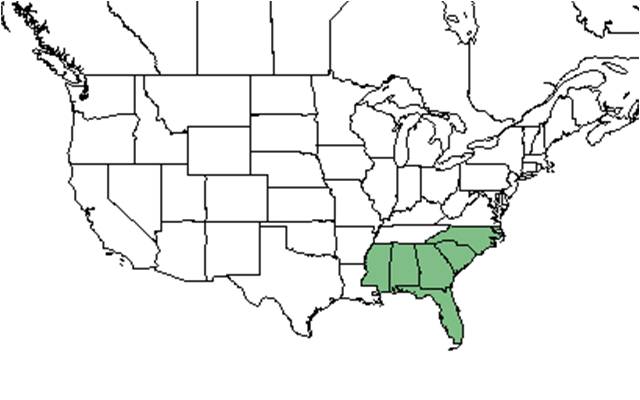Difference between revisions of "Gordonia lasianthus"
KatieMccoy (talk | contribs) |
KatieMccoy (talk | contribs) (→Seed dispersal) |
||
| Line 39: | Line 39: | ||
===Seed dispersal=== | ===Seed dispersal=== | ||
| + | The majority of seeds fall with in a radius three times the height of the parent tree. Wind shakes the seeds out of the capsules, the empty capsules will remain attached to the parent tree until peduncle and capsule abscission<ref name="fs"/>. | ||
| + | |||
===Seed bank and germination=== | ===Seed bank and germination=== | ||
===Fire ecology=== <!--Fire tolerance, fire dependence, adaptive fire responses--> | ===Fire ecology=== <!--Fire tolerance, fire dependence, adaptive fire responses--> | ||
Revision as of 19:09, 16 December 2015
| Gordonia lasianthus | |
|---|---|

| |
| Photo taken by Gil Nelson | |
| Scientific classification | |
| Kingdom: | Plantae |
| Division: | Magnoliophyta - Flowering plants |
| Class: | Magnoliopsida - Dicotyledons |
| Order: | Theales |
| Family: | Theaceae |
| Genus: | Gordonia |
| Species: | G. lasianthus |
| Binomial name | |
| Gordonia lasianthus (L.) Ellis | |

| |
| Natural range of Gordonia lasianthus from USDA NRCS Plants Database. | |
Common name: loblolly bay
Contents
Taxonomic notes
Description
A description of Gordonia lasianthus is provided in The Flora of North America.
Loblolly bay is a perennial, evergreen tree with large, white, fragrant, cup-shaped flowers. The leaves are leathery, entire, oblong and oblanceolate [1][2]. It often grows with sweet bay, (Magnolia virginiana) and is easily distinguishable by having a light green underside while sweet bay has a white underside [3].
Distribution
Found in hydric habitats throughout the Coastal Plain.
Ecology
Habitat
Gordonia lasianthus has been found along margins of titi swamps, densely wooded hammocks, swampy depressions, cypress domes, an ecotone between a titi-sweet bay swamp and a pond pine flatwood, ravine bottoms, shrub bogs, wet pine flatwoods, mesic steepheads, pocosins, bayheads, and bald cypress/mixed hardwoods swamps. Seedlings have been observed to require significant site disturbance exposing mineral soil, to become established (Gresham and Lipscomb 1985). It has been found to occur in disturbed areas such as cut-over pinewoods and powerline corridors (FSU Herbarium). Grows in acidic, swampy soils, with an accumulation of organic matter. Soil types include Spodosols, Inceptisols, Ultisols, and Histosols[4] and has been observed to grow in loamy sand (FSU Herbarium). Associated species include Stewartia, Illicium, Ilex opaca, Ilex glabra, Persea borbonia, Magnolia glauca, Rhus vernix, Clethra, Cliftonia, Nyssa sylvatica, Cyrilla racemiflora, Pinus elliottii, Quercus nigra, Liquidambar, Magnolia virginiana, Oxydendron, Illicium floridanum, Myrica cerifera, Liriodendron, Pickneya, Rhododendron viscosum, Lyonia lucida, Serenoa, Osmunda, Sphagnum, and Lycopodium (FSU Herbarium).
Loblolly bay is rarely observed to occur in pure stands (Gresham and Lipscomb 1985), but has been observed to be the dominate canopy in some Carolina bays (Dimick et al. 2010).
Phenology
The large, white fragrant flowers can be found flowering May through July (FSU Herbarium). The fruit is a hard, woody, five-valved capsule about 0.6 inches long, four to eight flat, winged seeds can be found in each valve [4].
Seed dispersal
The majority of seeds fall with in a radius three times the height of the parent tree. Wind shakes the seeds out of the capsules, the empty capsules will remain attached to the parent tree until peduncle and capsule abscission[4].
Seed bank and germination
Fire ecology
Pollination
The following Hymenoptera families and species were observed visiting flowers of Gordonia lasianthus at Archbold Biological Station (Deyrup 2015):
Sphecidae: Ectemnius rufipes ais
Vespidae: Pachodynerus erynnis, Polistes dorsalis hunteri
Use by animals
Diseases and parasites
Conservation and Management
Cultivation and restoration
Photo Gallery
References and notes
Deyrup, M.A. and N.D. 2015. Database of observations of Hymenoptera visitations to flowers of plants on Archbold Biological Station, Florida, USA.
Florida State University Robert K. Godfrey Herbarium database. URL: http://herbarium.bio.fsu.edu. Last accessed: October 2015. Collectors: Loran C. Anderson, Sarah Baxter, James R. Burkhaulter, N.H. Chevalier, Andre F. Clewell, H.S. Conard, H.A. Davis, Wayne R. Faircloth, A. Gholson Jr., R.K. Godfrey, D.W. Hall, Don Harrison, E.A. Hebb, R. Kral, O. Lakela, S.W. Leonard, Hui Lin Li, T. Myint, J.B. Nelson, Jackie Patman, James D. Ray Jr., C. Rhinehart, P.L. Redfearn Jr., Grady W. Reinert, Cecil R. Slaughter, A.G. Shuey, R.R. Smith, E. Tyson, D.B. Ward, Jean W. Wooten. States and Counties: Florida: Alachua, Baker, Bay, Columbia, DeSoto, Dixie, Escambia, Flagler, Franklin, Gadsden, Hamilton, Hardee, Highlands, Hillsborough, Jefferson, Lake, Leon, Liberty, Madison, Manatee, Marion, Nassau, Okaloosa, Orange, Polk, Putnam, Seminole, Taylor, Volusia, Wakulla, Walton.
Georgia: Clarke, Grady. Pennsylvania: Phillidelphia. South Carolina: Pickens. Compiled by Tall Timbers Research Station and Land Conservancy.